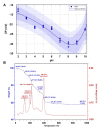Zinc Oxide Nanocomposites-Extracellular Synthesis, Physicochemical Characterization and Antibacterial Potential
- PMID: 33007802
- PMCID: PMC7579083
- DOI: 10.3390/ma13194347
Zinc Oxide Nanocomposites-Extracellular Synthesis, Physicochemical Characterization and Antibacterial Potential
Abstract
This research presents, for the first time, the potential of the Lactobacillus paracasei LC20 isolated from sweet whey as a novel, effective and accessible source for post-cultured ZnO nanocomposites synthesis. The obtained nanocomposites were subjected to comprehensive characterization by a broad spectrum of instrumental techniques. Results of spectroscopic and microscopic analysis confirmed the hexagonal crystalline structure of ZnO in the nanometer size. The dispersion stability of the obtained nanocomposites was determined based on the zeta potential (ZP) measurements-the average ZP value was found to be -29.15 ± 1.05 mV in the 7-9 pH range. The ZnO nanocomposites (NCs) demonstrated thermal stability up to 130 °C based on the results of thermogravimetric TGA/DTG) analysis. The organic deposit on the nanoparticle surface was recorded by spectroscopic analysis in the infrared range (FT-IR). Results of the spectrometric study exhibited nanostructure-assisted laser desorption/ionization effects and also pointed out the presence of organic deposits and, what is more, allowed us to identify the specific amino acids and peptides present on the ZnO NCs surfaces. In this context, mass spectrometry (MS) data confirmed the nano-ZnO formation mechanism. Moreover, fluorescence data showed an increase in fluorescence signal in the presence of nanocomposites designed for potential use as, e.g., biosensors. Despite ZnO NCs' luminescent properties, they can also act as promising antiseptic agents against clinically relevant pathogens. Therefore, a pilot study on the antibacterial activity of biologically synthesized ZnO NCs was carried out against four strains (Escherichia coli, Staphylococcus aureus, Klebsiella pneumoniae and Pseudomonas aeruginosa) by using MIC (minimal inhibitory concentration). Additionally, the colony forming units (CFU) assay was performed and quantified for all bacterial cells as the percentage of viable cells in comparison to a control sample (untreated culture) The nanocomposites were effective among three pathogens with MIC values in the range of 86.25-172.5 μg/mL and showed potential as a new type of, e.g., medical path or ointment formulation.
Keywords: Lactobacillus paracasei; antimicrobial activity; extracellular synthesis; mechanism of formation; nanocomposites; organic deposit; zinc oxide.
Conflict of interest statement
The authors declare no conflict of interest.
Figures








Similar articles
-
Comprehensive study upon physicochemical properties of bio-ZnO NCs.Sci Rep. 2023 Jan 11;13(1):587. doi: 10.1038/s41598-023-27564-w. Sci Rep. 2023. PMID: 36631546 Free PMC article.
-
Synthesis and characterization of cry protein coated zinc oxide nanocomposites and its assessment against bacterial biofilm and mosquito vectors.Int J Biol Macromol. 2022 May 31;208:935-947. doi: 10.1016/j.ijbiomac.2022.03.165. Epub 2022 Mar 30. Int J Biol Macromol. 2022. PMID: 35364199
-
Conjugation of micro/nanocurcumin particles to ZnO nanoparticles changes the surface charge and hydrodynamic size thereby enhancing its antibacterial activity against Escherichia coli and Staphylococcus aureus.Biotechnol Appl Biochem. 2021 Jun;68(3):603-615. doi: 10.1002/bab.1968. Epub 2020 Jun 28. Biotechnol Appl Biochem. 2021. PMID: 32533898
-
Synthesis of strontium oxide-zinc oxide nanocomposites by Co-precipitation method and its application for degradation of malachite green dye under direct sunlight.Heliyon. 2023 Oct 11;9(10):e20824. doi: 10.1016/j.heliyon.2023.e20824. eCollection 2023 Oct. Heliyon. 2023. PMID: 37867874 Free PMC article.
-
Zinc oxide nanoparticles: Synthesis, antiseptic activity and toxicity mechanism.Adv Colloid Interface Sci. 2017 Nov;249:37-52. doi: 10.1016/j.cis.2017.07.033. Epub 2017 Aug 26. Adv Colloid Interface Sci. 2017. PMID: 28923702 Review.
Cited by
-
Bioinspired Green Synthesis of Chitosan and Zinc Oxide Nanoparticles with Strong Antibacterial Activity against Rice Pathogen Xanthomonas oryzae pv. oryzae.Molecules. 2020 Oct 19;25(20):4795. doi: 10.3390/molecules25204795. Molecules. 2020. PMID: 33086640 Free PMC article.
-
Green Synthesis of MOF-Mediated pH-Sensitive Nanomaterial AgNPs@ZIF-8 and Its Application in Improving the Antibacterial Performance of AgNPs.Int J Nanomedicine. 2023 Aug 28;18:4857-4870. doi: 10.2147/IJN.S418308. eCollection 2023. Int J Nanomedicine. 2023. PMID: 37662688 Free PMC article.
-
Efficacy of Various Types of Berries Extract for the Synthesis of ZnO Nanocomposites and Exploring Their Antimicrobial Potential for Use in Herbal Medicines.Biomed Res Int. 2022 Aug 16;2022:9914173. doi: 10.1155/2022/9914173. eCollection 2022. Biomed Res Int. 2022. Retraction in: Biomed Res Int. 2023 Jun 21;2023:9815767. doi: 10.1155/2023/9815767. PMID: 36017391 Free PMC article. Retracted.
-
Single-step hydrothermal synthesis of zinc oxide nanorods for potential use as nano-antibiotics without seeding or bases.PLoS One. 2024 Nov 4;19(11):e0313224. doi: 10.1371/journal.pone.0313224. eCollection 2024. PLoS One. 2024. PMID: 39495763 Free PMC article.
-
The mechanism of metal-based antibacterial materials and the progress of food packaging applications: A review.Ceram Int. 2022 Dec 1;48(23):34148-34168. doi: 10.1016/j.ceramint.2022.08.249. Epub 2022 Aug 27. Ceram Int. 2022. PMID: 36059853 Free PMC article. Review.
References
-
- Ogunyemi S.O., Abdallah Y., Zhang M., Fouad H., Hong X., Ibrahim E., Masum M.M.I., Hossain A., Mo J., Li B. Green synthesis of zinc oxide nanoparticles using different plant extracts and their antibacterial activity against Xanthomonas oryzae pv. oryzae. Artif. Cells Nanomed. Biotechnol. 2019;47:341–352. doi: 10.1080/21691401.2018.1557671. - DOI - PubMed
-
- Kalpana V.N., Kataru B.A.S., Sravani N., Vigneshwari T., Panneerselvam A., Devi Rajeswari V. Biosynthesis of zinc oxide nanoparticles using culture filtrates of Aspergillus niger: Antimicrobial textiles and dye degradation studies. OpenNano. 2018;3:48–55. doi: 10.1016/j.onano.2018.06.001. - DOI
-
- Król A., Railean-Plugaru V., Pomastowski P., Buszewski B. Phytochemical investigation of Medicago sativa L. extract and its potential as a safe source for the synthesis of ZnO nanoparticles: The proposed mechanism of formation and antimicrobial activity. Phytochem. Lett. 2019;31:170–180. doi: 10.1016/j.phytol.2019.04.009. - DOI
Grants and funding
LinkOut - more resources
Full Text Sources

